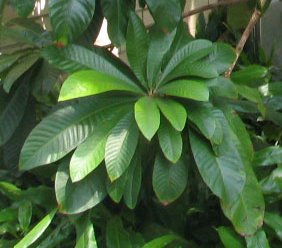
Phytoremediation technologies use living plants to clean up soil, air and water contaminated with hazardous contaminants. It is defined as "the use of green plants and the associated microorganisms, along with proper soil amendments and agronomic techniques to either contain, remove or render toxic environmental contaminants harmless". The term is an amalgam of the Greek phyto (plant) and Latin remedium. Although attractive for its cost, phytoremediation has not been demonstrated to redress any significant environmental challenge to the extent that contaminated space has been reclaimed.

The Sapotaceae are a family of flowering plants belonging to the order Ericales. The family includes about 800 species of evergreen trees and shrubs in around 65 genera. Their distribution is pantropical.
Phelline is a genus of shrubs and the sole member of the family Phellinaceae, a family of flowering plants endemic to New Caledonia. It is placed in the order Asterales and is related to two other small plant families: Alseuosmiaceae and Argophyllaceae. It contains ten species.

A hyperaccumulator is a plant capable of growing in soil or water with high concentrations of metals, absorbing these metals through their roots, and concentrating extremely high levels of metals in their tissues. The metals are concentrated at levels that are toxic to closely related species not adapted to growing on the metalliferous soils. Compared to non-hyperaccumulating species, hyperaccumulator roots extract the metal from the soil at a higher rate, transfer it more quickly to their shoots, and store large amounts in leaves and roots. The ability to hyperaccumulate toxic metals compared to related species has been shown to be due to differential gene expression and regulation of the same genes in both plants.
This list covers known nickel hyperaccumulators, accumulators or plant species tolerant to nickel.

Pycnandra is a genus of trees in the family Sapotaceae described as a genus in 1876.
Pichonia is a group of trees in the Sapotaceae described as a genus in 1890.
Planchonella rufocostata is a species of plant in the family Sapotaceae. It is endemic to New Caledonia. As with other species in the same genus, it possesses stamens that are located below the tube orifice; a multi-seeded fruit, as well as foliaceous cotyledons embedded in endosperm.
Planchonella povilana is a species of plant in the family Sapotaceae. It is endemic to New Caledonia. As with other species in the same genus, it possesses stamens that are located below the tube orifice; a multi-seeded fruit, as well as foliaceous cotyledons embedded in endosperm.
Planchonella mandjeliana is a species of plant in the family Sapotaceae. It is endemic to New Caledonia. As with other species in the same genus, it possesses stamens that are located below the tube orifice; a multi-seeded fruit, as well as foliaceous cotyledons embedded in endosperm.
Planchonella luteocostata is a species of plant in the family Sapotaceae. It is endemic to New Caledonia. As with other plants in the same genus, it possesses stamens that are located below the tube orifice; a multi-seeded fruit, as well as foliaceous cotyledons embedded in endosperm.
Planchonella latihila is a species of plant in the family Sapotaceae. It is endemic to New Caledonia. As with other plants in the same genus, it possesses stamens that are located below the tube orifice; a multi-seeded fruit, as well as foliaceous cotyledons embedded in endosperm.
Planchonella glauca is a species of plant in the family Sapotaceae. It is endemic to New Caledonia. As with other species in the same genus it possesses stamens that are located below the tube orifice; a multi-seeded fruit, as well as foliaceous cotyledons embedded in endosperm.
Planchonella crenata is a species of plant in the family Sapotaceae. It is endemic to New Caledonia. As with other species in the same genus, it possesses stamens that are located below the tube orifice; a multi-seeded fruit, as well as foliaceous cotyledons embedded in endosperm.

Phyllanthus balgooyi is an herbaceous plant in the family Phyllanthaceae, found in Palawan and Sabah. The plant is a hyperaccumulator of nickel, with a concentration of the metal exceeding 16% in the plant's phloem sap.

Agrostis castellana, the highland bent, dryland bent or dryland browntop, is a species of cool-season grass in the family Poaceae. It is native to Macaronesia and the Mediterranean, has been widely introduced elsewhere, and is considered an invasive species in some locales. It is a hyperaccumulator of zinc and lead.
Xylopia pancheri is a species of flowering plant in the family Annonaceae, native to New Caledonia. It occurs in the maquis on ultramafic soils.
Pycnandra decandra is a species of flowering plant in the family Sapotaceae, endemic to New Caledonia. It grows as a small shrub or tree. It was first described by Xavier Montrouzier in 1860 as Chrysophyllum decandrum.






